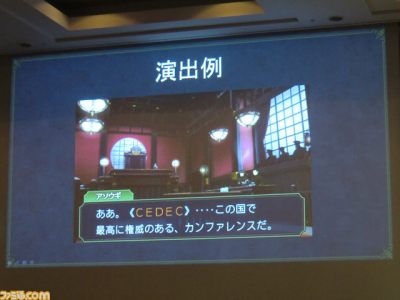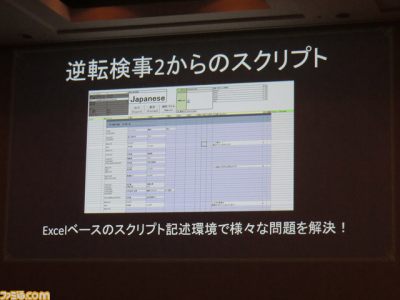Title: The Secret Of How The Gyakuten Saiban Feeling Is Created! Creating an 3D Adventure Game: A Demonstration of the Gyakuten Saiban Script System (CEDEC 2015) / 「『逆転裁判』らしさが生まれる秘密! “逆転裁判のスクリプトシステムによる実演を交えた3Dアドベンチャーの作り方”【CEDEC 2015】」
Source: Famitsu
Source: Famitsu
Summary: Computer Entertainment Developers Conference (CEDEC) 2015 was held in August 2015 and one of the lectures featured was one of Capcom programmer Kimoto Masahiro, who had worked on Gyakuten Saiban 5 (Ace Attorney 5 – Dual Destinies) and Dai Gyakuten Saiban – Naruhodō Ryūnosuke no Bōken (The Great Ace Attorney: Adventures). In the lecture, Kimoto explains how scripts are used to create the typical feel of the Gyakuten Saiban series, by controlling factors like camera, text speed and music. He explains how the tools were created to simplify the task for the planners, but also points out what other problems were created because of their work process. This article is a translation of Famitsu's report on the lecture.
Images are taken from the source article. Copyright belongs to their respective owners.
Japan’s greatest game developers conference CEDEC 2015 was held in Pacifico Yokohama between August 26-28 2015. This is a report of the session “Creating an 3D Adventure Game: A Demonstration of the Gyakuten Saiban Script System”.
The session’s lecturer was the programmer Kimoto Masahiro of Capcom’s Development Division 4. The focus of the lecture was the creation of scripts (simple programs).
The lecture started with a presentation of Kimoto’s resume and an introduction of Gyakuten Saiban. Readers here will probably already know this, but Gyakuten Saiban is a series of adventure games starring defense attorneys. Players take on the role of the defense attorney, prove the innocence of their clients who are accused of a crime they didn’t commit and try to win a Not Guilty verdict. As the title Turnabout Trial suggest, the games are about winning a hard-fought “turnabout” from doom. There are spin-off games like the Gyakuten Kenji (Ace Attorney Investigation) series. The latest entry in the series, Dai Gyakuten Saiban – Naruhodō Ryūnosuke no Bōken (The Great Ace Attorney: Adventures), was released recently in July.
Kimoto Masahiro
* 2011
- Doctorate in Information Sciences Osaka University - Graduate School of Information Science and Technology Sciences
- Entered Capcom
- Working on Gyakuten Saiban 5
- Control through scripts
- Characters
- Sound
- Camera
- Mini-games
- Designing and implementing dev support tools
Working on Dai Gyakuten Saiban
And with that, the lecture on the creation of scripts started. In simple terms, the creation process of Gyakuten Saiban series usually starts with the scenario writer(s) creating the scenario, which is converted to scripts. Performance directors then add the dramatic presentation and this is at the end converted to executable data.
The term “performance directors” is used here, but there are no Capcom employees who specialize in stage direction, so this work is usually done by several planners. The term “performance directors” is used for convenience by Kimoto, which this report will do too.
Let’s look at how it’s all done in more detail. First the scenario. The scenario writer will write the manuscript of the game while following certain rules. It’d be possible to just convert this scenario to a script and have it executed as a game, but then the characters would just stand still while their lines appears on screen, so Kimoto explains this wouldn’t be any fun as a game.
The term “performance directors” is used here, but there are no Capcom employees who specialize in stage direction, so this work is usually done by several planners. The term “performance directors” is used for convenience by Kimoto, which this report will do too.
Let’s look at how it’s all done in more detail. First the scenario. The scenario writer will write the manuscript of the game while following certain rules. It’d be possible to just convert this scenario to a script and have it executed as a game, but then the characters would just stand still while their lines appears on screen, so Kimoto explains this wouldn’t be any fun as a game.
Scenario
↓ ← Programmers (Flow control, flag control)
Script
↓ ← Performance directors
Script + Dramatic presentation
↓
Scenario writers write the manuscript follow certain rules (putting ■ in front of people who speak, lines that start with [Tab] are messages etc. ). This is reflected like this in the game.
The performance directors can then control the speed of the text, pause time, the sound effects and BGM that play, screen flashes and filters to make the presenation more game-like. Kimoto explains that this dramatic presentation is very important to give these games their distinctive feel, but the work takes a lot of time.
The performance directors can then control the speed of the text, pause time, the sound effects and BGM that play, screen flashes and filters to make the presenation more game-like. Kimoto explains that this dramatic presentation is very important to give these games their distinctive feel, but the work takes a lot of time.
So how are the scripts created? They changed their way of working tremendously halfway in the series. Until Gyakuten Saiban 4 (Ace Attorney 4 – Apollo Justice), they’d write the commands directly in the scenario data, but Kimoto confesses that it was prone to input mistakes.
Starting with the spin-off title Gyakuten Kenji 2 ("Turnabout Prosuector 2"), they started using an Excel file to create the scripts. They can select comments from a menu, so input errors are minimized, and there’s no need to memorize all the commands yourself anymore. It’s possible to directly input the commands too, but if there’s an input error the cell will become red, and it will jump to the faulty cell so you can correct it immediately.
When you select a command in the script, it’s necessary to pass an argument (a kind of data). When using a new method, they made it so it’s shown clearly on screen how you need to pass an argument, so there’s no need to perfectly memorize all the commands, and you can check everything at once.
They also made it so that depending on the argument passed, other arguments will also automatically change accordingly. For example, if you pass a character and their animation as an argument, and you change a character, the animations you are able to pick will change accordingly.
There is also a localization tool baked in. You can input English text while looking at the Japanese. You can also have the English version compiled when the game’s done just by selecting the English version.
Because it would take a tremendous amount of work to convert the scenario text to a script file by hand, they have mostly automated the process with tools. They have made it so that certain fixed dramatic performance actions, like moving the camera to the person speaking, are done automatically. Kimoto also explained about certain techniques that helped them minimize mistakes, like having a reset command for the text speed at the start of a text box, to make the game forget the settings of the previous box.
Kimoto explains that Gyakuten Saiban’s script has 800.000 to 900.000 character count, so it’d be very difficult to correct and change things if everything was in one single file. That’s why they split the scripts up per scene, for about 500 files. But there are also problems that arise precisely because they split it over multiple files
One example is that the control of flags and inventory. More and more data is accrued as you progress in the game, and it wouldn’t be practical to specify that in every single script file. They solved this problem with a preset script that specifies the flags and inventory before a script starts.
Kimoto explains that Gyakuten Saiban’s script has 800.000 to 900.000 character count, so it’d be very difficult to correct and change things if everything was in one single file. That’s why they split the scripts up per scene, for about 500 files. But there are also problems that arise precisely because they split it over multiple files
One example is that the control of flags and inventory. More and more data is accrued as you progress in the game, and it wouldn’t be practical to specify that in every single script file. They solved this problem with a preset script that specifies the flags and inventory before a script starts.
Another problem is that the scene direction would change compared to the scene preceding it. If the camera angle, BGM and the animations of the characters aren’t passed between scripts, the transition between scenes won’t be smooth and feel off.
It’s possible to make it so the game will check the script file of the preceding scene first and reflect those settings, but it takes a lot of time if the game would have to do that each and every time. They solved it by creating “metadata” that’s taken over by the following scene. This metadata is also useful when checking the script.
Creating even more 3D-like presentation
The Gyakuten Saiban series made the jump to 3D with Gyakuten Saiban 5 (Ace Attorney 5 – Dual Destinies). They wanted to make even more use of 3D with the following title, Dai Gyakuten Saiban – Naruhodō Ryūnosuke no Bōken. The game for example introduced characters who walked in from the side, or who slowly approach the camera
.
They made it so they can control the camera through the scripts, like the perspective, moving the focal point and changing the angle.
They made it so they can control the camera through the scripts, like the perspective, moving the focal point and changing the angle.
They also introduced a function to control line of sight. This allowed them to control where the eyes of a character are directed at. This gave the performance directors even more creative room, as it can even change existing animations dramatically. Kimoto confesses he wasn’t sure whether such a function was really necessary at first, but that he was surprised that it really added something when he saw it in action.
Finally, Kimoto demonstrated how to use the script in the lecture. He first showed off a boring in-game scene with only the scenario text, but by adding animations that matched the lines of the characters and adding BGM, he made the same scenario text look far more appealing as a game.
Kimoto explains that performance direction is really important and that Gyakuten Saiban was only created after a long process of trial and error. With that, the session ended.






















No comments:
Post a Comment